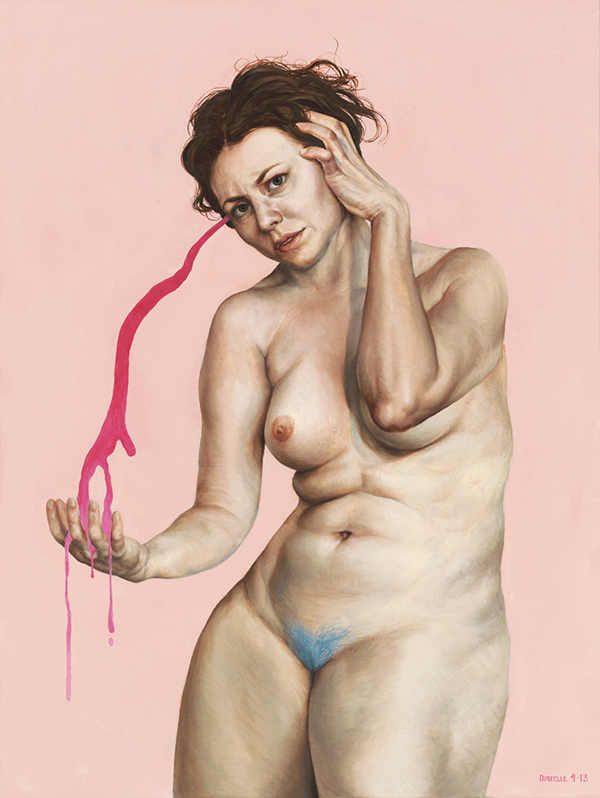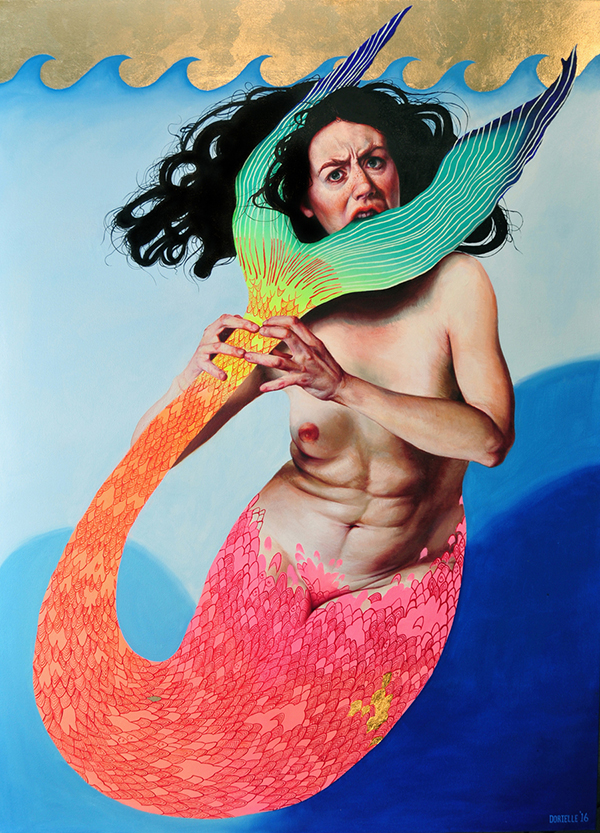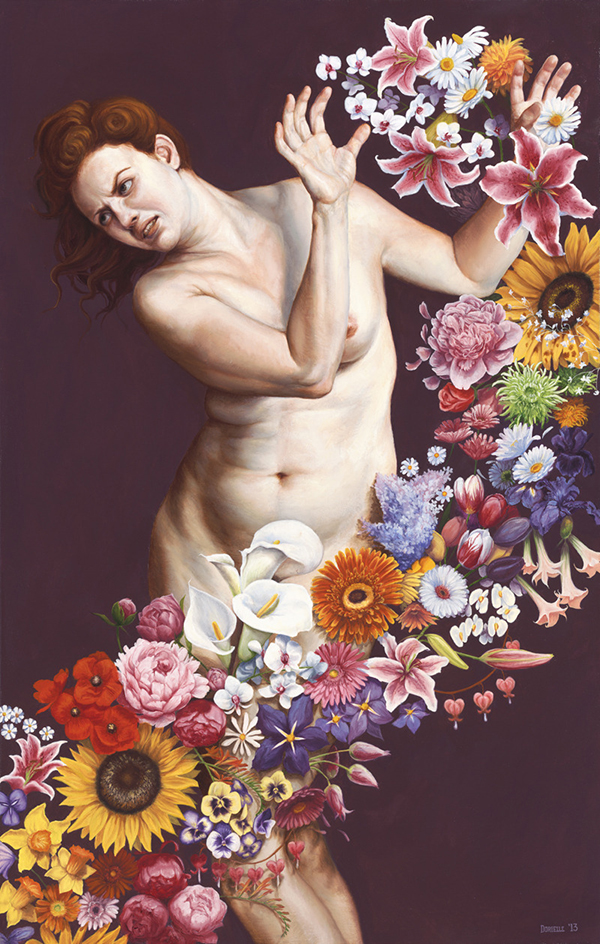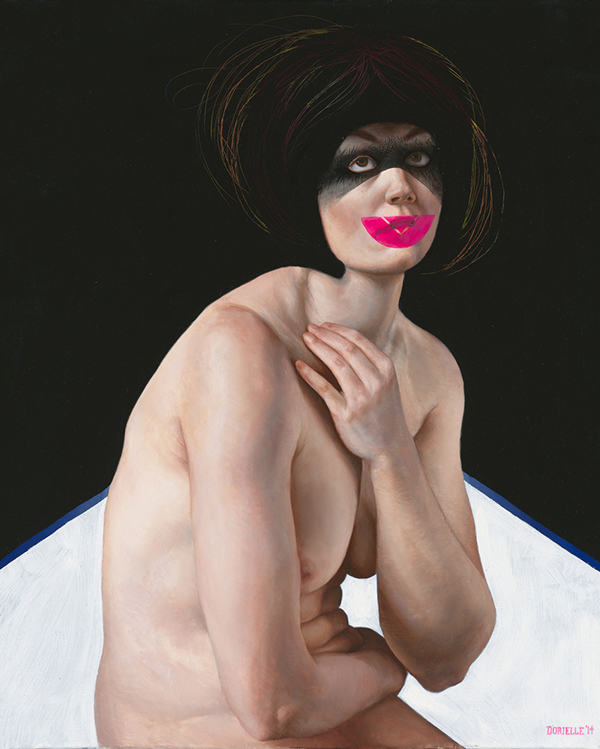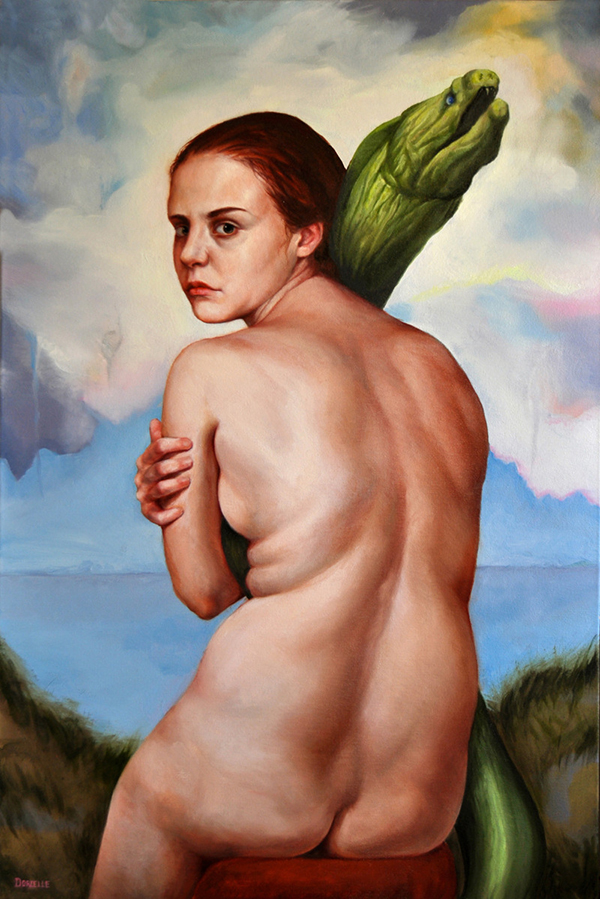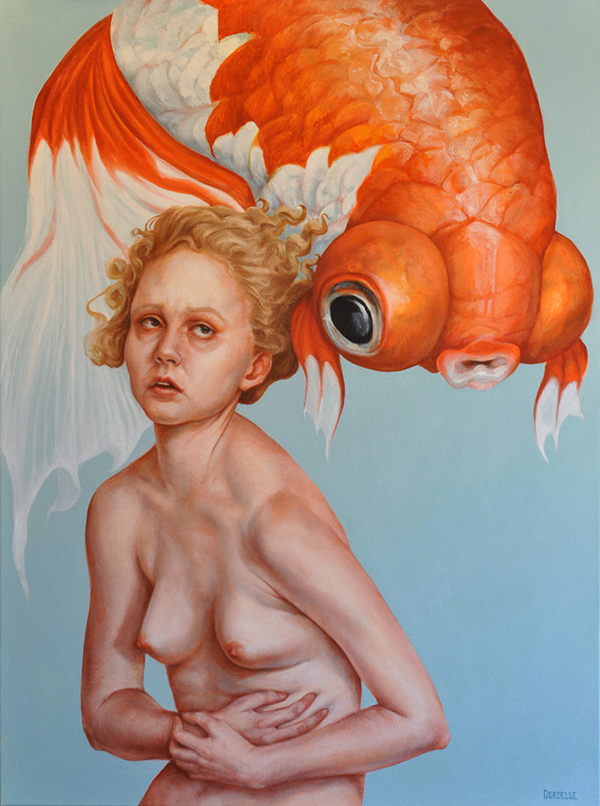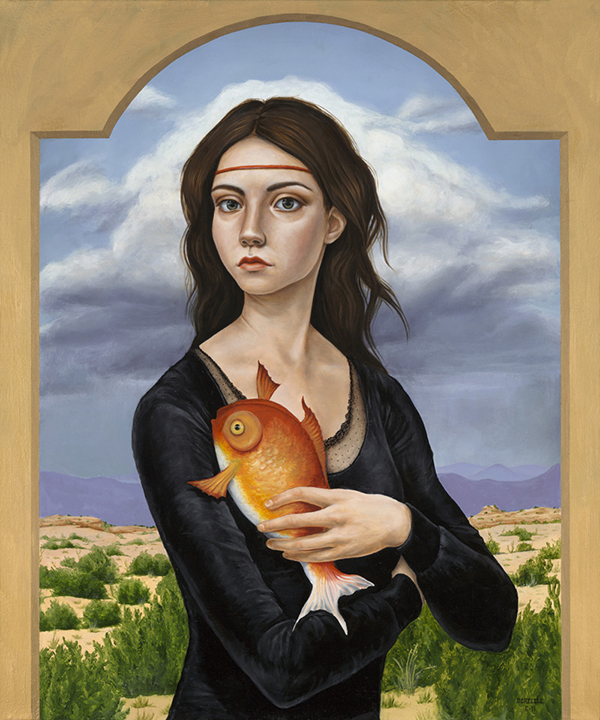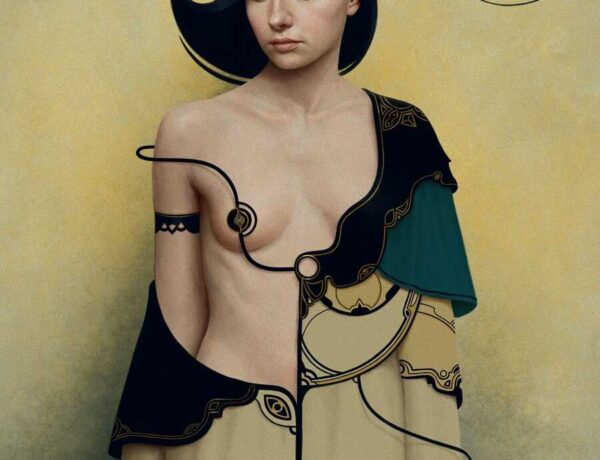The artwork of Dorielle Caimi is at once striking. A viewer’s glance at her paintings is immediately returned by the fierce eyes of Dorielle’s characters. These women bare all, not just their flesh, but also their unprotected emotions and experiences. Their portrayal is so direct and authentic that one is immediately aware of the dynamic dialogue an audience has with work of this quality. The encounter, and ensuing observation, is profound, as are the concepts the spectator finds contained within. Dorielle was kind enough to be interviewed for Issue 014 of beautiful.bizarre. She is currently living and working in Albuquerque, New Mexico and is represented by Gusford Gallery of Los Angeles.
Web | Facebook | Instagram | Twitter
Justine: Although I know you’re asked very often it would be great to give our readers a little bit of background, personal as well as artistic. Do you have a childhood story that you feel exemplifies you as the person you are now? Were your parents supportive of your natural proclivity to artistic work?
Dorielle Caimi: I guess an interesting and defining story about me is that I was born into a Korean religious movement called The Unification Church, commonly known as “The Moonies.” It was a movement that was started in the 1970’s by Reverend Sun Myung Moon, whom his followers believe is the second coming of Christ, The Messiah take 2, if you will. Many people remember the movement for its mass-wedding ceremonies, wherein Rev. Moon would pick the spouses for thousands of his followers and they would all get married simultaneously in a venue like Madison Square Garden within a week. Although I emancipated myself from the movement at 14 years old, it has shaped a great deal of who I am. Per the custom of the movement, I was sent to Seoul, South Korea to live there for a year when I was 13 years old to learn Korean, Korean culture, and, of course, the belief system of the Unification Church.
Leaving my family to live in Korea was one of the most difficult, confusing, and incredibly unique experiences of my life. We were under tremendous spiritual and educational discipline. There’s a “spiritual retreat center” there called Cheom Pyeong where we would be taken to “liberate” our dead ancestors and rid ourselves of evil spirits that were trapped in our bodies. We would do this by hitting ourselves and each other over and over again for hours at a time in hot and sweaty lecture halls, until we were covered with bruises. This place was my nightmare, but I was convinced back then that I had to save all the spirits that resided in my body. Unfortunately, I found the teachings of the Unification Church erred on the side of misogyny and was degrading towards women. When we gathered for lectures, the women always had to sit on the left because the left hand side represented Satan. I felt that I had to apologize just for existing as a woman. After a year of this, I told my parents that I was done with the church. They respected my decision. They’ve always respected my decisions. My parents are also highly intelligent and creative individuals (and not really involved with the church anymore), so they saw the value in my pursuing the arts and were supportive. They still are.
When I took myself out of the movement, I had to discover who I was and what I stood for. I began to look for my truth. I also began to look for needs in the world to which I could relate and lend a hand. I developed my own identity and strengths and harnessed them in a way that could inform a real purpose in my being here. I started studying the history of women in the arts and in history. I studied other religious scriptures and philosophies. I went to Cornish College of the Arts and earned a BFA in 2010, and then I granted myself permission to start a fierce and unapologetic art career.
Your work can be very emotionally heavy, yet the colors, props and, at times, facial expressions of your portraits tend towards humor. How did you come to decide that this was the way you’d like to express yourself? Was it a natural progression?
As Roger Rabbit says, “Laughter is a very powerful thing.” I’ve always tended towards silliness. It was a way for me to relieve tension in my life. As an artist, however, I’ve found that humor helps with the delivery of my deeper messages. Humor has been known to do many things for people:
1. It builds rapport: a bond of trust is created when people laugh together.
2. It provides the opportunity to move forward: when people trust you, they are more open to what you have to say.
3. It diffuses conflict and releases defenses: I’ve found that it is very difficult for someone to raise a hand in anger at someone who makes them laugh.
4. It also creates resiliency, lightheartedness; it’s a form of self-preservation and a powerful defense mechanism.
5. It’s just fun.
Early on, I learned very quickly that whenever I tried to create work that existed on one side of the emotional spectrum, such as matching dark sentiment with dark emotion and dark colors, the work came off as either preachy, too self-aware, contrived, or literal. I studied other art forms like writing, music, and acting. When I studied acting, I learned that the key to a good performance was to not do too much of the emotional work for the audience. A literary element that I appreciate the most is satire, so I employ that in my work quite often. From music, I learned the value of the spaces between the notes: that allowing the eye to breathe through a simple composition works best for what it is that I am conveying through my art.
The women in your paintings often have very arresting and direct looks. Are these the actual personalities of the subjects that you try to illustrate, or are they more the feeling you get when interacting with the subject?
Well, very few of my paintings use other actual people as subjects (most are composites that I put together from many images). I have a few models, but the concept for the work is always fleshed out before I choose the model(s). That said, my work has very little to do with other individual experiences, per se. My current body of work has to do with what I’ve personally experienced as a young woman, and of what I have extracted from womankind through empathy, study and observation, through female recourse, and simply being human and dealing with it.
You’ve stated in other interviews that although you identified as a feminist, you have now moved past that and consider yourself a proponent of gender equality. How do you feel about the current state of affairs affecting women’s health, trans or gay rights, and the like? Is the world progressing?
Yes, it is progressing. Not without its discomfort, of course. But I am so thrilled to be a part of a cultural landscape that is shifting its understanding of people and their sexuality. When it comes to women’s health, I believe women should absolutely have full and unadulterated say over their bodies and unborn babies. Women also need more emotional, spiritual, and mental support when it comes to their health. When men trust and respect women, we will be empowered to make clear decisions. Our unborn children pull at our heartstrings until we would literally die for our unborn. I have zero tolerance for shame and control when it comes to women’s health, her reproductive rights, and what she learns through her own sexual experiences. Her experiences are hard enough without the judgment.
With the emergence of gay, trans and queer people, we are now being confronted with the whole idea that perhaps it is a stereotypical falsity that femininity and masculinity are restricted to their respective roles. What a game-changing thought! That’s why I consider the term “feminism” to be outdated. Now we have men, dressing/identifying as women, and ever-changing their sexual identity to that of “female” and visa versa. It’s really cool because it’s creating more portals of empathy for people. But I understand that it is scary for people who are used to the traditional paradigms of how we should exist in society. Religion, for example, tends to hold onto ancestral traditions, which is good but only if it doesn’t uphold doctrines that suppress other individuals. As comedian, Sarah Silverman, said during her Ted Talk, and I paraphrase, “I understand why people need religion. I literally exploded from my dad’s balls into existence. That’s crazy, and it can be overwhelming. So some of us need religion to tell us what to do with that daunting information.” There is indeed a new wave of people populating our existence with new ideas on how to live and create our lives, but I think we need to be compassionate to one another (on all sides), and loving but firm. We could learn so much from the voices of the people who rise from the oppressed. My hope is that we learn, grow, stay open and think critically about how we can move humanity forward in a way that includes all the little babies to whom our mothers decided to give birth.
Many of your paintings brought to my mind antique Victorian photographs of women in psychiatric hospitals. There is this incredible play between wildness, creative vitality, but also deep distraction or pain. Do you consider your work to be advocating for mental health awareness?
Sure. In 2014, I was living (or maybe dying) in Oakland. I was bedridden for 7 months, injured from painting, unable to hold my own head up without creepy crawling debilitating pain, hands and arms constantly numb. I just spent hours and hours every day with a towel rolled up under my neck, stoned, listening to NPR, remembering or forgetting who I used to be. “Unrequited Lightning” is a painting I did that illustrated how I felt at the time: ideas for paintings would come to me and I couldn’t put them to canvas because I couldn’t hold my head up. So I had to let the ideas go (her hair is spread out because that’s what my hair looked like, spread out on my pillow). At the time, I didn’t have health insurance or money or employment. It got to the point where I felt most comfortable being in a room in silence, lying in bed, finding the shapes in the ceiling, motionless. I was also very sick at the time. My liver was home to a colony of liver flukes called Clonorchis Sinensis, a parasite that is common in Korea. My circulation was poor; my immune system was very weak; and the stress at the time was insurmountable for me. Then one day, I finally got sick enough that I started losing consciousness in my kitchen and we had to call 911. The paramedics thought that I had Meningitis. There was never a definitive diagnosis, which will always perplex me. Two weeks later, confused and exhausted from months of pain and stress, and barely functioning, I came home to Albuquerque, New Mexico to my mom’s house to recover, and I did, physically. But the worst was yet to come.
I’ve always suffered with depression, but it was during this time that chronic situational depression consumed me for 26 months. It was way worse than the physical pain. There were many circumstantial misfortunes that occurred in a relentless procession in my life at that time that broke my heart. I lost myself. I became a shell. I became a woman who felt empty and unable to experience joy. I felt like everything in my life that had defined me was taken away. I wanted to end. I felt like I had jumped ship with burning sails and in-letting water, only to be drowning in an ocean. The painting I did of the mermaid called “Surface Tension” was a direct reaction to the feeling that life was drowning me…”Fuck it,” I thought, “If I’m going to survive, I’m going to have to grow a pair…of fins.” But I met many incredible people and healers during this time who rose out of the woodwork and showed me compassion, love, and understanding. Some let me rest in their lifeboats; others came to me from the abundance of hindsight and told me that it gets better. They encouraged me to keep going. And I did. And it was excruciating. My compassion for people who suffer with depression and other forms of mental illness went to a whole new level of empathy.
When it comes to women and our psychiatric concern, I think we’ve been very much misunderstood. We have been the sorry-sayers for so long. We have been the bending reeds. We have been the creative souls with a menstrual cycle. We have taken the back seat of history. We’ve been taught to be perfect instead of brave. We have had every inch of our flesh criticized. I have been witness to many-a-woman (myself included) whose preoccupation with her appearance was distracting to the point of loss of authentic self. It’s really quite tragic when you think about it. I can’t help but think of all the women who have nodded in the direction of power, while thinking of another, unheard solution…uninvited to the round table.
“Mind is the master power that moulds and makes- and Man is Mind…” -British philosopher, James Allen.
“—we are the very thinking substance that was used to create us. Hello?!” -writer and badass, Jen Sincero
Emotional/mental health is linked to everything that is executed on this planet. It is the agency that sorts out all the information we are given and creates points-of-views. Mental health needs to be explored and understood with positive openness because psyches created from misunderstanding, fear, and rejection create angry, close-minded, and scared points-of-views.
There are many criticisms of museums and galleries alike that female artists are underrepresented. Gorilla Girls are famous for their poster “Do women have to be naked to get into the Met. Museum?” How do you traverse the art world, and have you had experiences that speak to this particular? Are you the type of person who likes to plan ahead or someone who prefers to go with the flow? What can the world expect from you in the next few years?
Ok. So the Guerrilla Girls are a group of women – maybe men too…wouldn’t it be rad if it were men behind those masks? – who have fought for women’s rights in the art world since 1984. They function anonymously to advocate for accurate representation of culture through the arts, namely focusing on women and minorities’ representation. And to be frank, women are sorely, sadly, and shamefully underrepresented in the art world. Progress has been slow. A fire needs to be lit under everyone’s asses so that the world can benefit from a culturally rounded and accurately expressed artistic experience.
Who knows how muddled our viewpoints have become with our societal/social conditioning? My mission is to represent an authentic point-of-view through my art to the best of my abilities. I take things as they come; I go with the flow. I do the best with what I have. I change my mind weekly to reflect the changing heartbeat of my own intuition.
That said, here is what you can expect next from me: men. I’m starting to understand that men need to be illuminated from the women’s point of view, which is something I can actually do. For centuries, men have painted women as he sees them. What would happen if women started painting men as we see them? For example, my dad worked every day for 30 or so years to support my family. He is the epitome of the repressed creative individual. He is a playwright, documentary filmmaker, songwriter, visual artist, actor, musician, political rights activist, and philosopher who worked most of his life in a cubicle. Men make sacrifices too: big and unimaginable ones. And I intend to lay in paint this role we call “MAN” and how we dance with him. I hope to explore men’s strengths through the vulnerability of what it means to be “male.” I want to examine this role of protector; of father; of heart breaker; of husband; of lover; of critical thinker; of boy; of hunter; of dude; of father, son, and brother. I want to look into the discoveries that can be made when women and men, or those who identify as such, reach for each other as allies and breathe together as mammals who breathe as our fleeting ancestors before us breathed in hopes that we might live, love, understand, and laugh together.



